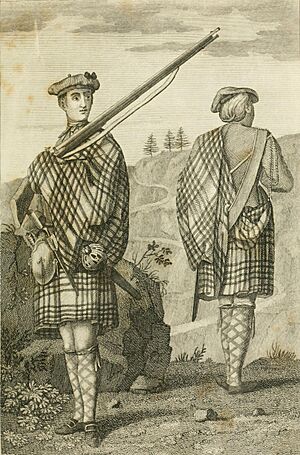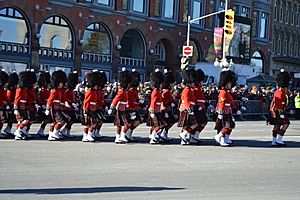Scottish regiment facts for kids
A Scottish regiment is a special type of regiment (a large group of soldiers) that has a name linked to Scotland. These regiments also wear parts of traditional Scottish clothing. They were formed after Scotland and England joined together in 1707. Many Scottish regiments served Britain in wars or became part of armies in Commonwealth countries. Even today, they are known for being brave and strong in battle.
Traditionally, Scottish regiments are often shown as very fierce fighters in movies and stories. In Scotland, regiments from the Lowlands (the southern part of Scotland) didn't start wearing distinct Scottish uniforms until the late 1800s. Even then, they didn't always wear the kilt, which is the most famous part of a Highland soldier's uniform.
Contents
History of Scottish Regiments
Lowland Regiments: The First Scottish Soldiers
The Lowland regiments were formed even before the more famous Highland regiments. The oldest Lowland regiment was the Royal Scots, created in 1633. Others like The Royal Scots Fusiliers (1678) and the King's Own Scottish Borderers (1689) followed. For many years, these regiments served bravely in many wars.
At first, they looked much like other British Army soldiers. But in 1881, changes were made to their uniforms. Lowland regiments began wearing special jackets called "doublets" and tartan trousers called "trews." This gave them a unique look, different from English, Welsh, Irish, and Highland soldiers. They didn't wear kilts (except for their pipers) or tall feather bonnets. This helped people tell them apart from Highland soldiers.
Highland Regiments: Brave Fighters from the Mountains
The first Highland regiments were created in the 1700s. They were meant to recruit soldiers only from the Scottish Highlands (the northern, mountainous part of Scotland). However, over time, fewer people lived in the Highlands. So, Highland regiments started recruiting soldiers from the Lowlands and other places too. During the First and Second World Wars, many men from the Highlands did join.
When the first Highland regiments were formed, the Highlands had seen several rebellions against the government. Because of this, some people didn't fully trust the Highlanders at first. The first Highland regiment, the Black Watch, was created to help the government control the Highlands.
Later, during the Seven Years' War, Britain needed more soldiers. So, William Pitt the Elder decided to create new Highland regiments to fight. These regiments helped Britain win the war, securing Canada and expanding its power in India. After the war, these regiments were disbanded. But other Highland regiments were formed later and fought in many wars, including the Napoleonic Wars.
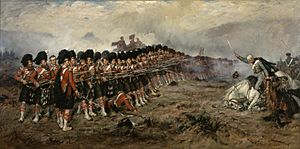
By the time of Queen Victoria (who ruled from 1837 to 1901), Highlanders were fully trusted. Queen Victoria loved Scottish culture, especially the Highlands. Highland regiments became very famous for their bravery in wars like the Crimean War and the Indian Mutiny. Their reputation even influenced Lowland regiments, who then started wearing tartan. For example, the Highland Light Infantry was a Highland regiment, but it recruited soldiers from Glasgow in the Lowlands.
Scottish bagpipes became popular in many countries. This was often because of the pipers in Highland regiments who served all over the British Empire. Many Commonwealth countries also formed their own Highland regiments, often linking up with British Army Scottish regiments.
Scottish Regiments in the United Kingdom
Current Regiments in the British Army

Here are some of the Scottish regiments serving in the British Army today:
- Royal Scots Dragoon Guards
- Scots Guards
- Royal Regiment of Scotland
- 19th Regiment Royal Artillery
- 105th Regiment Royal Artillery
- 32 Signal Regiment
- 154 (Scottish) Regiment RLC
- G (Messines) Company, London Guards
- 51st Highland Volunteers
- 52nd Lowland Volunteers
The British Army also has the Scottish and North Irish Yeomanry, which includes:
- A (Ayrshire (Earl of Carrick's Own) Yeomanry) Squadron in Ayr
- B (North Irish Horse) Squadron in Belfast and Coleraine
- C (Fife and Forfar Yeomanry/Scottish Horse) Squadron in Cupar
- E (Lothians and Border Yeomanry) Squadron in Edinburgh
Former Regiments in the British Army
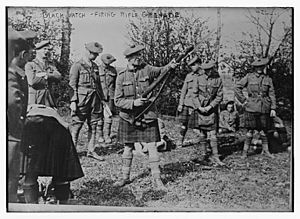
Many Scottish regiments have been part of the British Army in the past. Some of these famous regiments later joined together to form new, larger regiments.
Some well-known former Highland regiments include:
- The Black Watch (Royal Highland Regiment) (1725–2006)
- The Gordon Highlanders (1881–1994)
- The Argyll and Sutherland Highlanders (Princess Louise's) (1881–2006)
Some well-known former Lowland regiments include:
- The Royal Scots (The Royal Regiment) (1633–2006)
- The King's Own Scottish Borderers (1689–2006)
- The Cameronians (Scottish Rifles) (1881–1968)
The Atholl Highlanders: A Private Army
The Atholl Highlanders is a special Scottish regiment. It's not part of the official British Army. Instead, it's under the command of the Duke of Atholl and is based at Blair Castle. In 1844, Queen Victoria gave the regiment official "colours" (flags), making it a real regiment. It is the only legal private army in Europe!
Scottish Regiments in Other Countries
Scottish regiments were also formed in many other countries, especially those that were once part of the British Empire.
Australia
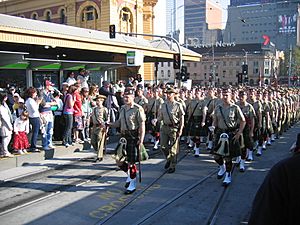
Today, the Australian Army Reserve has five Scottish "Kilted Companies." These are smaller units that keep the Scottish traditions alive. They include:
- A Company, 2nd/17th Battalion, Royal New South Wales Regiment (Black Watch)
- B Company, 5th/6th Battalion, Royal Victoria Regiment (Gordon Highlanders)
- A Company, 10th/27th Battalion, Royal South Australia Regiment (Mackenzie Seaforth Highlanders)
- B Company, 16th Battalion, Royal Western Australia Regiment (Cameron Highlanders)
- B Company, 41st Battalion, Royal New South Wales Regiment (Argyle and Sutherland Highlanders)
Canada

Canada has many Scottish regiments in its army reserve, called the Primary Reserve. There are 16 Canadian-Scottish infantry (foot soldier) regiments and one artillery (big guns) regiment. The Black Watch (Royal Highland Regiment) of Canada is the oldest Canadian-Scottish infantry regiment.
Some Canadian-Scottish regiments include:
- 48th Highlanders of Canada
- The Argyll and Sutherland Highlanders of Canada (Princess Louise's)
- The Black Watch (Royal Highland Regiment) of Canada
- The Calgary Highlanders
- The Cameron Highlanders of Ottawa (Duke of Edinburgh's Own)
- The Canadian Scottish Regiment (Princess Mary's)
- The Essex and Kent Scottish
- The Lake Superior Scottish Regiment
- The Seaforth Highlanders of Canada
- The Toronto Scottish Regiment (Queen Elizabeth The Queen Mother's Own)
New Zealand
The New Zealand Army used to have the New Zealand Scottish Regiment. It started as an infantry regiment in 1939. Later, it became an armoured (tank) unit. This unit was officially disbanded in 2016.
South Africa
The South African Army still has several Scottish regiments. These are reserve units, meaning they are not full-time soldiers but can be called upon when needed. In 2019, some of these regiments were renamed to better reflect African military history.
Current Scottish regiments in South Africa include:
- Chief Makhanda Regiment (formerly First City Regiment)
- Gonnema Regiment (formerly Cape Town Highlanders Regiment)
- Solomon Mahlangu Regiment (formerly Transvaal Scottish Regiment)
United States
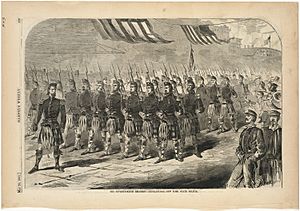
During the American Civil War, the United States Army had two Scottish regiments. One of these was part of the New York State Militia before the war. These former regiments include:
- 12th Illinois Infantry Regiment (1861–1865)
- 79th New York Volunteer Infantry (1858–1876)
See also
- Military of Scotland


